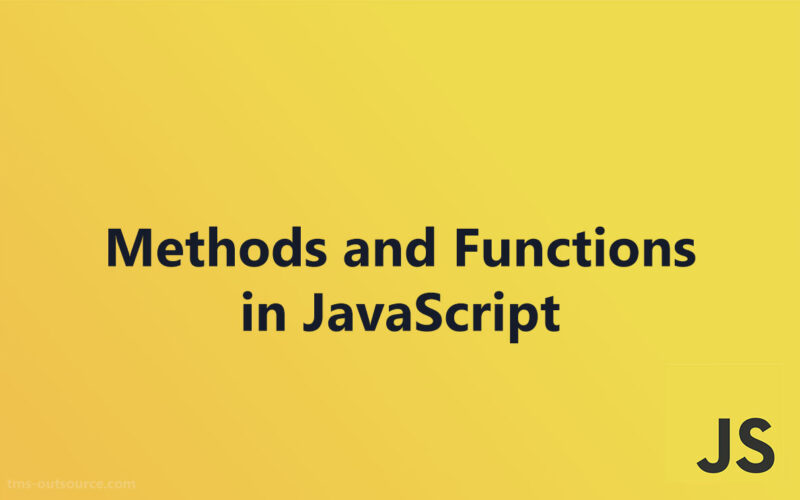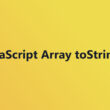The Difference Between Methods and Functions in JavaScript

JavaScript is a versatile language that powers much of the dynamic behavior on modern web pages. A fundamental aspect of the language involves understanding the difference between methods and functions in JavaScript.
While both are crucial for writing efficient code, they serve distinct roles in the context of an application. This article will delve deeper into their definitions, syntax, and practical applications to clarify their uses and benefits.
Overview of JavaScript Functions
Definition and Basic Concepts
Function as a standalone block of code
A function in JavaScript is essentially a standalone block of code designed to perform a specific task when it is called or invoked.
This is one of the core components in scripting and programming, enabling modular, manageable, and reusable code structures within applications.
Functions are powerful because they allow developers to define a block of logic that alters input, processes data, or handles the control flow of an application, all isolated from the global scope unless intentionally connected.
Syntax of defining a function
Defining a function starts with the function keyword followed by a name, parentheses ( ) — which may enclose parameters — and a set of curly braces { } that encapsulate the code block to be executed. Here’s an example:
function sayHello() {
console.log("Hello, world!");
}
Legacy syntax still in wide use allows function expressions, which can be anonymous and assigned to a variable, such as:
const greet = function() {
console.log("Good day!");
};
Characteristics of Functions
Parameters and return values
Functions may accept parameters — specific data pieces passed into the function — which makes them highly flexible for programming various behaviors. For instance, a function can be written to sum two numbers with these numbers passed in as parameters:
function sum(x, y) {
return x + y;
}
The return statement determines the output of the function. If return is not used, the function outputs undefined by default.
Invocation of functions
Functions are invoked using their name followed by parentheses. If parameters are required, they are placed within the parentheses. Here’s how the earlier sum function can be called:
sum(5, 3); // returns 8
It’s also possible to store the result of a function in a variable, enhance dynamic functionalities such as callbacks, or use functions as arguments to other functions, refining the application’s flow control.
Scope and hoisting
The scope of a function defines where the variables, parameters, and the function itself are accessible within the code after being declared. JavaScript functions typically create their own scope, meaning any variables declared within a function are not accessible outside of it, ensuring a controlled environment:
function exampleFunction() {
let local = "I'm local only to this function";
}
console.log(local); // ReferenceError: local is not defined
Hoisting is a JavaScript mechanism where variable and function declarations are moved to the top of their containing scope during the compilation phase. This means functions can be called before they appear to be defined in the script:
displayName(); // logs: "Declared later in the code"
function displayName() {
console.log("Declared later in the code");
}
This unique behavior stems from the way JavaScript is interpreted by the browser, enabling a lot of flexibility but requiring a solid understanding to manage effectively.
Overview of JavaScript Methods
Definition and Association with Objects
Method as a function within an object
In JavaScript, a method is essentially a function attached to an object. This distinction is crucial in the difference between methods and functions in JavaScript, as methods are inherently tied to the objects they are part of. This allows them to operate on data that is contained within the object, empowering object-oriented programming and encapsulation.
Syntax of defining a method
Methods are defined in the context of an object. Here’s a straightforward example where a method is defined within an object literal:
let person = {
firstName: "Jane",
lastName: "Doe",
greet: function() {
console.log("Hello, " + this.firstName);
}
};
In this instance, greet is a method of the person object. You can invoke this method by using dot notation linked to its object, like person.greet().
Characteristics of Methods
Contextual use of ‘this’
The this keyword in a method refers to the object to which the method belongs. It’s what makes methods particularly powerful for managing and accessing the properties of their parent objects. The contextual linkage of this allows each instance of an object to use its methods to manipulate its own data:
function User(name) {
this.name = name;
this.getName = function() {
return this.name;
};
}
let user = new User("John");
console.log(user.getName()); // Outputs 'John'
In the above example, this.name refers to the name property of the specific instance of the User object.
Access and manipulation of object’s properties
Methods are not only about accessing object properties but also about manipulating them. Consider a method that changes a property value:
let person = {
name: "Sarah",
age: 28,
birthday: function() {
this.age += 1; // increments the age property by 1 each time it's called
}
};
console.log(person.age); // 28
person.birthday();
console.log(person.age); // 29
This flexibility is a cornerstone of using methods within objects, enabling dynamic interactions with the object’s internal data. Moreover, the use of methods for accessing and manipulating data maintains the integrity and encapsulation of the object’s properties, fitting perfectly within modern JavaScript applications and frameworks.
Detailed Syntax Comparison

Function Syntax
Declaration and expression forms
Understanding the difference between methods and functions in JavaScript begins with grasping their syntax. Functions can be declared in multiple ways, with the fundamental forms being declaration and expression.
A function declaration is perhaps the most straightforward approach:
function multiply(a, b) {
return a * b;
}
Here, multiply is hoisted, meaning it can be called before it’s actually defined in the script, thanks to JavaScript’s interpretation behaviors.
In contrast, a function expression can be assigned to a variable. These are not hoisted, which means they cannot be called before they are defined:
const divide = function(a, b) {
return a / b;
};
Examples of function calls
Calling or invoking functions is straightforward. Once a function is defined, you can execute it by using its name followed by parentheses, optionally including parameters:
let resultMultiply = multiply(4, 3); // returns 12
let resultDivide = divide(10, 2); // returns 5
These examples show how functions operate as independent units within your code, capable of being reused wherever needed.
Method Syntax
Accessing methods through object properties
Methods, in contrast to standalone functions, are accessed through the properties of the objects to which they belong. The typical way to access and call a method is by using dot notation:
let person = {
name: "Alice",
greet: function() {
console.log("Hello, " + this.name);
}
};
person.greet(); // outputs: "Hello, Alice"
This notation links the method to its owner object, providing clarity and structure, especially in complex scripts.
Built-in and custom methods
JavaScript provides a plethora of built-in methods especially for data types and structures – for example, string or array objects:
let message = "Hello, world!";
console.log(message.toUpperCase()); // outputs: "HELLO, WORLD!"
let numbers = [1, 2, 3];
numbers.push(4); // numbers array becomes [1, 2, 3, 4]
Custom methods can also be defined to add specific functionalities to your objects, enhancing the bespoke behavior of your applications:
let dog = {
name: "Baxter",
speak: function() {
console.log(this.name + " barks.");
}
};
dog.speak(); // outputs: "Baxter barks."
These examples underline how methods integrate seamlessly into objects, acting on and manipulating their data directly. This encapsulates behavior with data leading to cleaner and more intuitive code management.
Existence and Independence
Functions: Standalone and Global Attachment
Functions in the global scope
Functions defined in the global scope are accessible from any other code in the same environment. This means that once a function is declared, it can be called in any other part of the JavaScript code, unless it’s shadowed by another function or variable with the same name in a more localized scope.
function globalFunction() {
console.log("Accessible everywhere!");
}
function testFunction() {
globalFunction(); // The global function can be called inside this local function.
}
globalFunction(); // It can also be called directly in the global scope.
While convenient, placing functions in the global scope can lead to conflicts in larger, more complex systems where different scripts might declare functions with the same names or interact in unpredictable ways.
Self-invoking functions
One interesting facet of JavaScript functions is the self-invoking function, also known as an Immediately Invoked Function Expression (IIFE). It allows the function to execute automatically once defined, which is especially useful for initializing applications without affecting the global scope:
(function() {
console.log("This function runs right away!");
})();
This pattern is often used to manage and protect the scope and to avoid polluting the global environment.
Methods: Dependency on Objects
Necessity of an object for methods
Methods are inherently connected to objects; they do not exist independently. Each method needs to be called on an object or, more precisely, it needs to be a property of an object. This relationship encapsulates the method within the object’s context, providing direct access to other properties and methods on the same object using this.
let cat = {
name: "Whiskers",
speak() {
console.log(`${this.name} says meow`);
}
};
cat.speak(); // Calls the speak method on the cat object.
Examples of built-in object methods
JavaScript provides numerous built-in methods on native objects like Arrays, Strings, and others, which facilitate powerful and expressive coding techniques:
let fruits = ["Apple", "Banana", "Cherry"];
fruits.push("Date"); // Adds a new item to the fruits array.
let message = "Hello, world!";
let shoutedMessage = message.toUpperCase(); // Converts the string to uppercase.
These methods modify the internal state of the objects they belong to or provide new data based on the object’s current state, demonstrating how methods are tied to the concrete instances of their objects.
Execution and Invocation
Calling Functions
Direct vs indirect invocation
In JavaScript, functions can be called directly using their names followed by parentheses, which may or may not include arguments. This is the most straightforward approach to function invocation:
function displayMessage() {
console.log("Hello, this is a direct call!");
}
displayMessage(); // Direct invocation
Indirect invocation involves using methods such as call() or apply(), which allow more control over the function’s execution context, or this value:
function greet(user) {
console.log(`Hello, ${user}`);
}
greet.call(null, "Anna"); // Indirect invocation using call
Recursion and self-invocation possibilities
Functions also have the unique capability to invoke themselves, a concept known as recursion. This can be very powerful for tasks such as iterating over data structures:
function countDown(fromNumber) {
console.log(fromNumber);
let nextNumber = fromNumber - 1;
if (nextNumber > 0) {
countDown(nextNumber);
}
}
countDown(5);
Additionally, functions can be self-invoking or Immediately Invoked Function Expressions (IIFE), which run as soon as they are defined:
(function() {
console.log("This function runs itself!");
})();
Calling Methods
Using dot notation for method invocation
Methods are functions that are stored as object properties and are typically invoked using dot notation. This links the method call to the object it is part of, allowing easy access to other properties and methods within the same object:
let person = {
name: 'John',
introduce() {
console.log(`My name is ${this.name}`);
}
};
person.introduce(); // Method invocation using dot notation
Impact of object context on method execution
The context within which a method is executed is defined by the object it is called on. This is identified by the this keyword inside the method. Changing the object context can change how the method functions:
let person = {
name: "Jane",
greet() {
console.log(`Hello, I'm ${this.name}`);
}
};
let anotherPerson = {
name: "Bob"
};
anotherPerson.sayHello = person.greet;
anotherPerson.sayHello(); // Context is now 'anotherPerson', not 'person'
This flexibility allows methods to act on the data within their respective objects, but it also requires careful management to ensure they are called in the correct context.
Practical Applications and Examples
Functions in Use
Common function examples
Functions are the building blocks of JavaScript and can be used in myriad ways across the script. A typical example is a simple calculator function that performs arithmetic operations:
function add(a, b) {
return a + b;
}
console.log(add(2, 3)); // Outputs 5
Another example could be a function that checks if a number is even:
function isEven(num) {
return num % 2 === 0;
}
console.log(isEven(4)); // Outputs true
These functions demonstrate how versatile and integral functions are for performing operations and returning results based on input.
Functions without side effects (pure functions)
Pure functions are those that do not cause side effects, meaning they do not alter any state outside their scope, and given the same inputs, they will always produce the same output. Here’s an example:
function multiply(num1, num2) {
return num1 * num2;
}
This function simply multiplies two numbers and returns the result, without modifying any external variables or states.
Methods in Use
Manipulating object properties
Methods can be particularly useful for manipulating properties of the objects they belong to. Consider an object representing a bank account:
let bankAccount = {
balance: 1000,
deposit(amount) {
this.balance += amount;
},
withdraw(amount) {
if (amount <= this.balance) {
this.balance -= amount;
return amount;
}
return 0;
}
};
bankAccount.deposit(500);
console.log(bankAccount.balance); // 1500
bankAccount.withdraw(200);
console.log(bankAccount.balance); // 1300
These methods directly modify the balance property of the bankAccount object.
Enhancing functionality with prototype methods
Utilizing prototype methods allows augmenting the functionality of existing constructors. For example, enhancing a generic User constructor to greet a user could look like this:
function User(name, age) {
this.name = name;
this.age = age;
}
// Adding a greet method to the User prototype
User.prototype.greet = function() {
console.log(`Hello, my name is ${this.name} and I am ${this.age} years old.`);
};
let user1 = new User('Alice', 30);
user1.greet(); // Outputs: Hello, my name is Alice and I am 30 years old.
This method adds significant capabilities to user instances without altering the original constructor definition, demonstrating methods’ power in object-oriented programming.
FAQ On Difference Between Methods And Functions In JavaScript
What exactly differentiates a method from a function in JavaScript?
In JavaScript, the core distinction lies in context. Methods are functions tied to objects; they define behavior associated with an object and use ‘this’ to access object’s attributes. Functions, however, can operate independently, performing tasks without being bound to an object’s properties.
How do you define a method in JavaScript?
To define a method, embed a function within an object. Here’s a simple blueprint:
let obj = {
myMethod: function() {
console.log("Hello!");
}
};
This method, myMethod, can be invoked with obj.myMethod().
Can methods use parameters in JavaScript?
Absolutely, methods can accept parameters similar to functions. When defining a method that requires input, list the parameters within the parentheses, enhancing the method’s interactivity and functionality:
let person = {
greet: function(name) {
console.log('Hello, ' + name);
}
};
What is the purpose of ‘this’ keyword in methods?
The this keyword in methods is crucial—it references the object from which the method was called. By using this, methods can access and manipulate the object’s properties, allowing a tailored functionality based on the object’s state or attributes.
Do JavaScript methods need to be inside an object?
Yes, by definition, methods must reside within an object. They are essentially functions assigned as properties of objects, serving to conduct specific operations tied to those objects, such as modifying their data or invoking other methods.
What are some common uses of functions in JavaScript?
Functions in JavaScript are incredibly versatile, used for tasks ranging from simple calculations to complex operations. Common examples include manipulating numbers, handling user inputs, performing calculations and logic decisions, or even running asynchronous tasks with callbacks.
Are there performance differences between methods and functions?
Performance largely depends on how a method or function is implemented rather than the clinical definition. However, methods might involve additional overhead if they’re frequently modifying object properties.
Functions, especially pure functions without side-effects, are generally more predictable in terms of performance.
When should you use a function instead of a method?
Opt for a function when the task to be performed is generic and doesn’t need to interact with or alter the state of an object. Functions are ideal for operations that maintain independence from the objects, providing flexibility across different parts of your code.
How do inherited methods work in JavaScript?
In JavaScript, methods can be inherited in object prototypes. When an object is created using a constructor or class that inherits from another, methods from the parent are accessible to the child, allowing shared functionality and behaviors:
function Animal(name) {
this.name = name;
}
Animal.prototype.speak = function() {
console.log(this.name + ' makes a noise.');
};
Can functions be transformed into methods?
Yes, functions can be transformed into methods by assigning them to properties of an object. Once a function is associated with an object property, it can be treated as a method, capable of utilizing the object’s context through this:
let myFunction = function() {
console.log('Hello from function!');
};
let myObject = {
myMethod: myFunction
};Conclusion
Understanding the difference between methods and functions in JavaScript is more than academic; it’s about practical application in coding everyday solutions.
Methods, tied strongly to the object-oriented side of JavaScript, leverage the powerful this keyword to manipulate and access object data seamlessly.
Functions, on the other hand, stand apart with their ability to execute independently, making them versatile for a variety of programming scenarios, from simple calculations to complex asynchronous tasks.
Harnessing both effectively can lead to cleaner, more efficient code, enhancing both functionality and readability in your web development projects.
- Share Creatively With Apps Like Vimeo - June 27, 2024
- Converting Arrays with JavaScript Array toString() Method - June 27, 2024
- 4 Best Free AI Coding Tools for Developers - June 27, 2024








